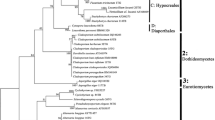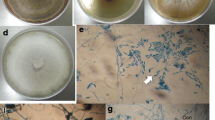Abstract
A total of 3611 fungal isolates were recovered from 4200 leaf segments incubated from 7 medicinal herbs during monsoon, winter and summer seasons. These fungal isolates belonged to teleomorphic Ascomycota (23.5%), anamorphic Ascomycota producing conidiomata (17.4%), anamorphic Ascomycota without conidiomata (46.9%), Zygomycota (1.42%) and sterile forms (10.6%). Chaetomium globosum, Aspergillus niger, Aureobasidium pullulans, Curvularia lunata, Fusarium spp., Penicillium spp., Pestalotiopsis spp., Trichoderma viridae, Cladosporium cladosporioides, were frequently isolated from more than one host plant. The number of endophytic isolates was higher in winter than in monsoon and summer seasons.
Similar content being viewed by others
References
Agrios GN. 1997. Plant Pathology, 4th edition. London: Academic Press, p. 635.
Aly AH, Debbab A, Kjer J, Proksch P. 2010. Fungal endophytes from higher plants: a prolific source of phytochemicals and other bioactive nature products. Fungal Diversity, 41: 1–16.
Arnold AE. 2008. Endophytic Fungi: Hidden Components of Tropical Community Ecology. In: Schnitzer S, Carson W. (eds), Tropical Forest Community Ecology. London: Blackwell Scientific, pp. 254–271.
Arnold AE, Lutzoni F. 2007. Diversity and host range of foliar fungal endophytes: are tropical leaves biodiversity hotspots? Ecology, 88: 541–549.
Arnold AE, Maynard Z, Gilbert GS, Coley PD, Kursar TA. 2000. Are tropical fungal endophytes hyper diverse? Ecological Letters, 3: 267–274.
Bacon CW, White JF. 2000. Microbial Endophytes. New York: Marcel Decker INC, pp. 237–261.
Barnett HL, Hunter BB. 1998. Illustrated Genera of Imperfect Fungi, 4th edn. New York: Prentice-Hall, Inc., p. 218.
Bills GF. 1996. Isolation and analysis of endophytic fungal communities from woody plants. In: Redlin S, Carris LM. (eds), Systematics, Ecology and Evolution of Endophytic Fungi in Grasses and Woody Plants. St Paul, MN: APS Press, pp. 31–65.
Clay K. 1988. Fungal endophytes of grasses: a defensive mutualism between plants and fungi. Ecology, 69: 10–16.
Clay K, Holah J. 1999. Fungal endophyte symbiosis and plant diversity in successional fields. Science, 285: 1742–1744.
Ernst M, Mendgen KW, Wirsel SGR. 2003. Endophytic fungal mutualists: seed-borne Stagonospora spp. enhances reed biomass production in axenic microcosms. Molecular Plant Microbe Interactions, 16: 580–587.
Fisher PJ, Anson AE, Petrini O. 1986. Fungal endophytes in Ulexeuropaeus and Ulexgallii. Transactions of the British Mycological Society, 86: 153–156.
Fröhlich J, Hyde KD. 1999. Biodiversity of palm fungi in the tropics: are global fungal diversity estimates realistic? Biodiversity and Conservation, 8: 1742–1744.
Gamboa MA, Laureano P, Bayman P. 2002. Measuring diversity of endophytic fungi in leaf fragments: Does size matter? Mycopathologia, 156: 41–45.
Gibbons JD. 1976. Non-parametric methods for quantitative analysis. New York: Holt, Rine hart and Winston, p. 463.
Göre ME, Bucak C. 2007. Geographical and seasonal influence on the distribution of fungal endophytes in Laurusnobilis. Forest Pathology, 37: 281–288.
Gunatilaka AAL. 2006. Natural products from plant-associated microorganisms: distribution, structural diversity, bioactivity, and implications of their occurrence. Journal of Natural Products, 69: 509–526.
Guo LD, Huang GR, Wang Y. 2003. Molecular identification of white morphotype strains of endophytic fungi from Pinustabulaeformis. Mycological Research, 107: 680–688.
Hawksworth DL. 2001. The magnitude of fungal diversity: the 1.5 million species estimate revisited. Mycological Research, 105: 1422–1432.
Huang WY, Cai YZ, Hyde KD, Corke H, Sun M. 2008. Biodiversity of endophytic fungi associated with 29 traditional Chinese medicinal plants. Fungal Diversity, 33: 61–75.
Hyde KD, Bussaban B, Paulus B, Crous PW, Lee S, Mckenzie EHC, Photita W, Lumyong S. 2007. Biodiversity of saprobic fungi. Biodiversity and Conservation, 16: 17–35.
Jeewon R, Hyde KD. 2006. Diversity and detection of fungi from environmental samples: traditional versus molecular approaches. In: Varma A, Oelmuller R. (eds), advanced techniques in Soil microbiology, Soil biology series. BerlinHeidelberg: Springer-Verlag press, pp. 1–11.
Koide K, Osono T, Takeda H. 2005. Colonization and lignin decomposition of Camellia japonica leaf litter by endophytic fungi. Mycoscience, 46: 280–286.
Krishnamurthy YL, Shankar Naik B, Shashikala J. 2008. Fungal communities in herbaceous medicinal plants, Malnad region, Southern India. Microbes and Environment, 23(1): 24–28.
Krishnamurthy YL, Shashikala J, Shankar Naik B. 2009. Diversity and seasonal variation of endophytic fungal communities associated with some medicinal trees of Western Ghats, Southern India. Sydowia, 61(2): 255–266.
Kusari S, Lamshöft M, Zühlke S, Spiteller M. 2008. An endophytic fungus from Hypericumperforatum that produces hypericin. J Nat Prod, 71: 159–162.
Lodge DJ, Fisher PJ, Sutton BC. 1996. Endophytic fungi of Manilkarabidentataleave in Puerto Rico. Mycologia, 88: 733–738.
Márquez LM, Redman RS, Rodriguez RJ, Roossinck MJ. 2007. A virus in a fungus in a plant: three-way symbiosis required for thermal tolerance. Science, 315: 513–515.
Pelaez F. 2005. Biological activities of fungal metabolites. In: An Z. (ed). Handbook of industrial mycology. New York: Marcel Dekker, p. 49–92.
Petrini O. 1986. Taxonomy of endophytic fungi of aerial plant tissues. Microbiology of Plant Microbe Interactions, 16: 580–587.
Redman RS, Sheehan KB, Stout RG, Rodrigues RJ, Henson JM. 2002. Thermo tolerance conferred to plant host and fungal endophyte during mutualistic symbiosis. Science, 298: 1581.
Rodrigues KF, Costa GL, Carvalho MP, Epifanio RDA. 2005. Evaluation of extracts produced by some tropical fungi as potential cholinesterase inhibitors. World Journal of Microbiology and Biotechnology, 21: 1617–1621.
Rodriguez RJ, White JF, Arnold AE, Redman RS. 2009. Fungal endophytes: diversity and functional roles. New Phytologist, 182: 314–330.
Rudgers JA, Clay K. 2007. Endophyte symbiosis with tall fescue: how strong are the impacts on communities and ecosystems? Fungal Biology Reviews, 21: 107–124.
Schulthess FM, Faeth SH. 1998. Distribution, abundances and association of the endophytic fungal community of Arizona fescue (Festucaarizonica Vasey). Mycology, 90: 569–578.
Schulz B, Boyle C. 2005. The endophytic continuum. Mycological Research, 109: 661–686.
Schulz B, Wanke U, Draenger S, Aust HJ. 1993. Endophytes from herbaceous plants and shrubs: effectiveness of surface sterilization methods. Mycological research, 97: 1447–1450.
Shankar Naik B, Shashikala J, Krishnamurthy YL. 2008. Diversity of endophytic fungal communities in shrubby medicinal plants of Western Ghat region, Southern India. Fungal Ecology, 1: 89–93.
Shankar Naik B, Shashikala J, Krishnamurthy YL. 2006. Study on diversity of endophytic communities from rice (Oryza sativa L.) and their antagonistic activities in vitro. Microbiological Research, 3: 290–296.
Shentu XP, Chen LZ, Yu XP. 2007. Anti-fungi activities and cultural characteristics of gingko endophytic fungus No. 1028. Acta Phytophyl Sin, 34: 147–152.
StrobelGA, Daisy B. 2003. Bioprospecting for microbial endophytes and their natural products. Microbiology and Molecular Biology Reviews, 67: 491–502.
Strobel GB, Daisy U, Castillo Harper JJ. 2004. Natural products from endophytic microorganisms. Natural Products, 67: 257–268.
Subramanian CV. 1983. Hyphomycetes, Taxonomy and Biology. New York: Academic Press, p. 450.
Suryanarayanan TS, Murali TS, Venkatesan G. 2003. Endophytic fungal communities in leaves of tropical forest trees: diversity and distribution patterns. Current Science, 85: 489–493.
Sutton BC. 1980. The Coelomycetes. London, England: Kew, Commonwealth Mycological Institute, p. 696.
White JF Jr, Col GT. 1985. Endophyte host associations in forage grasses. I. Distribution of Fungal endophytes in some species of Lolium and Festuca. Mycologia, 77: 323–327.
Wilson D. 2000. Ecology of woody plant endophytes. In: Bacon CW, White JF. (eds), Microbial endophytes. New York, Basel: Marcel Dekker, pp 389–420.
Wilson D, Carroll GC. 1994. Infection studies of Disculaquercina and endophyte of Quercusgarryana. Mycologia, 86: 635–647.
Yu W, Dai CC. 2011. Endophytes: a potential resource for biosynthesis, biotransformation, and biodegradation. Annals of Microbiology, 61: 207–215.
Zamora P, Martínez-Ruiz C, Diez JJ. 2008. Fungi in needles and twigs of pine plantations from northern Spain. Fungal Diversity, 30: 171–184.
Zar HJ. 2004. Biostatistical analysis, 4th edn. Delhi: Pearson Education Pvt. Ltd, p. 663.
Zhou L, Zhao J, Xu L, Huang Y, Ma Z, Wang J, Jiang W. 2009. Antimicrobial compounds produced by plant endophytic fungi. In: De Costa P, Bezerra P. (eds), Fungicides: Chemistry, Environmental Impact and Health Effects. New York: Nova Science Publishers, 91:116–119.
Author information
Authors and Affiliations
Corresponding author
Additional information
Project funding: The study was supported by University Grants Commission, India.
Rights and permissions
About this article
Cite this article
Shankar Naik, B., Krishnappa, M. & Krishnamurthy, Y.L. Biodiversity of endophytic fungi from seven herbaceous medicinal plants of Malnad region, Western Ghats, southern India. Journal of Forestry Research 25, 707–711 (2014). https://doi.org/10.1007/s11676-014-0511-9
Received:
Accepted:
Published:
Issue Date:
DOI: https://doi.org/10.1007/s11676-014-0511-9




